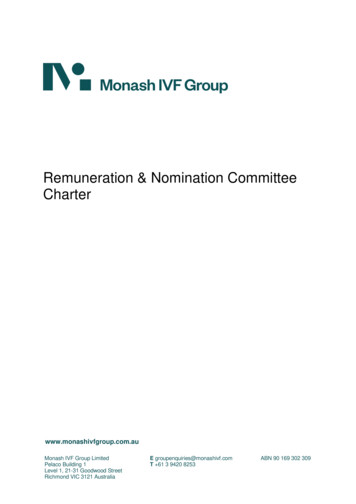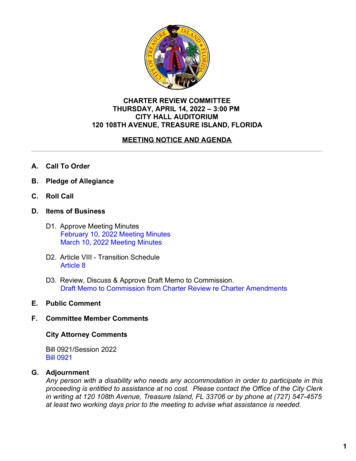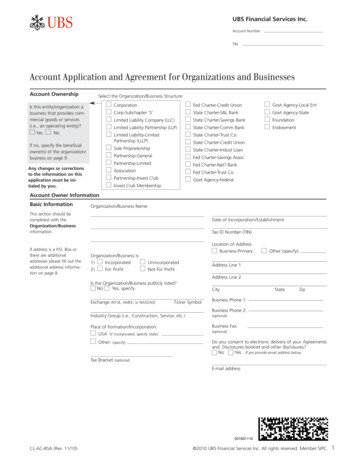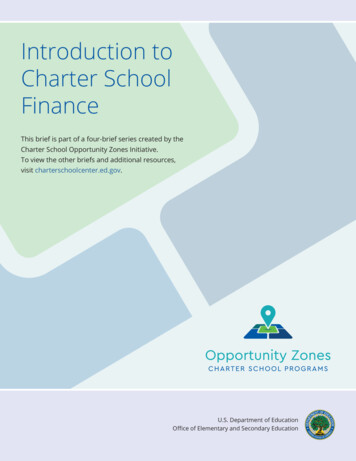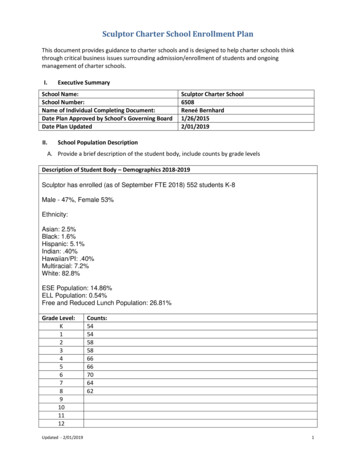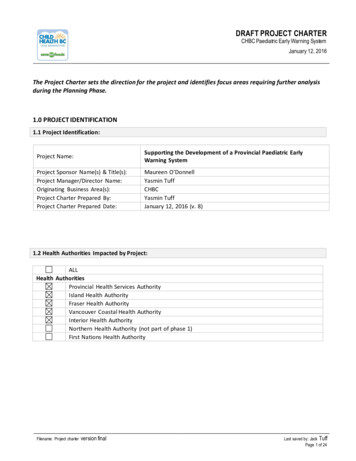
Transcription
DRAFT PROJECT CHARTERCHBC Paediatric Early Warning SystemJanuary 12, 2016The Project Charter sets the direction for the project and identifies focus areas requiring further analysisduring the Planning Phase.1.0 PROJECT IDENTIFICATION1.1 Project Identification:Project Name:Supporting the Development of a Provincial Paediatric EarlyWarning SystemProject Sponsor Name(s) & Title(s):Project Manager/Director Name:Originating Business Area(s):Project Charter Prepared By:Project Charter Prepared Date:Maureen O’DonnellYasmin TuffCHBCYasmin TuffJanuary 12, 2016 (v. 8)1.2 Health Authorities Impacted by Project:ALLHealth AuthoritiesProvincial Health Services AuthorityIsland Health AuthorityFraser Health AuthorityVancouver Coastal Health AuthorityInterior Health AuthorityNorthern Health Authority (not part of phase 1)First Nations Health AuthorityFilename: Project charterversion finalLast saved by: Jack TuffPage 1 of 24
DRAFT PROJECT CHARTERProvincial PEWSContents1.0 PROJECT IDENTIFICATION .11.1 Project Identification: .11.2 Health Authorities Impacted by Project: .12.0 PROJECT DRIVERS .32.1 Strategic Context .32.2 Clinical/Business Need.53.0 PROJECT BENEFITS MANAGEMENT.63.1 Proposed Benefits Statement.63.2 Proposed Project Outcomes .64.0 PROPOSED PROJECT SOLUTION .84.1 Proposed Project Outputs .84.2 Work in Scope .84.3 Work Out of Scope .94.4 Project Approach.94.5 Assumptions and Constraints.94.6 Linkages and Dependencies .105.0 PROPOSED PROJECT BUDGET.125.1 Project Budget Estimate Summary .126.0 PROPOSED PROJECT RESOURCES .126.1 Project Resources .136.2 External Project Resource Estimates.147.0 PROPOSED PROJECT SCHEDULE MILESTONES .157.1 Project Milestones .158.0 PROJECT CONTROLS .178.1 Reporting Management .178.2 Issue Management.178.3 Implementation & Education Strategy .18Education Strategy .18Implementation Strategy .19Logic model of provincial implementation of PEWS: .19The Implementation strategy will include the following components:.209.0 APPROVALS .209.1 Project Sponsor(s) Approval .20To view definitions of terms, refer to the Glossary of Terms Appendix.PLEASE PRINT DOUBLE-SIDED IN BLACK & WHITEVersion:v5Page 2 of 24
DRAFT PROJECT CHARTERProvincial PEWS2.0 PROJECT DRIVERS2.1 Strategic ContextIn the document, Setting Priorities for the BC Health System, 2014, the provincial government has identifiedspecific strategies around quality which include establishing guideline driven clinical care management systemto improve the quality, safety and consistency of key clinical services and to improve patient experience ofcare. iInternationally, Paediatric Early Warning Scores (PEWS) have been implemented for over 10 years, to improvesafety for hospitalized children. PEWS use is particularly common throughout the USA, England, Australia,Canada and Wales (Chapman et al. 2010, Lambert et al, 2014)i i . PEWS are implemented in healthcare facilitiesthat admit paediatric patients under the age of 18 years.The paediatric early warning system (PEWS) provides evidence-based methods to assess hospitalized childrenin different age groups, for risk of deterioration using vital sign parameter score and risk indicators supportedby evidence. In BC the PEWS system is made up of: a risk score based on physiological findings incorporated into paediatric flow sheet, an escalation protocol,a situational awareness bundle (evidence based risk factors), and a communication framework (SBAR).Together these system parts are designed to provide a standardized framework and language to identifypotential deterioration in a child; mitigate that risk; and escalate care as needed – all as early as possible.Case for Change: The incidence of cardiopulmonary arrest (CPA) in hospitalized children is relatively low howevermortality and morbidity remains high despite advances in resuscitation training, technology andtreatment. The devastating consequences of CPA on both child and family are well documented. Thereare also substantive financial costs to the healthcare system for ‘failing to rescue’ deterioratingchildren in hospital (Berg et al. 2008, North America, Tucker et al. 2009)i i i There is evidence indicating that mortality prevention is possible. A detailed confidential panel reviewof 126 child deaths in the UK concluded 63 of the 89 deaths occurring in hospital, (71%) wereavoidable or potentially avoidable (Pearson GA, 2008 CEMACH). i v This suggests an urgent need toimprove early identification and mitigation of deterioration in hospitalized children. Paediatric patients demonstrate physiologic and behavioural symptoms of deterioration 24 hours priorto CPA (Robson et al, 2013; McLellan et al. 2013). v Thus, an window of opportunity may exist withinwhich to identify children at risk of serious adverse events (SAE) in order to intervene earlier toimprove outcomes. (Haines C 2005, Tusker RC 2005, Tume L & Bullock I 2004). vi Internationally,Paediatric Early Warning Systems (PEWS) have been implemented to improve the safety forhospitalized children (CEMACH, 2008; Lambert et al, 2014)vi i In 2013/14 there were 36,377 paediatric hospital visits in BC. Of these children 1165 were transferredto a higher level of care at BC Children’s Hospital. The majority of BC hospital sites rely on general providers, who see predominately adults, but alsocare for children. A survey of nurses across these care settings was done in the summer of 2014 andrevealed that 40% of nurses responding to the survey reported caring for children once a week or less,Version:v5Page 3 of 24
DRAFT PROJECT CHARTERProvincial PEWSand 21% of nurses reported caring for children occasionally. 35% of the nurse respondents reportedthemselves as competent in distinguishing normal and abnormal vital signs in infants and children, and37% reported themselves as able to anticipate and respond to paediatric clinical deterioration or acuteurgent situations. The Paediatric Early Warning system offers tools and processes to support nurses and physicians inassessment, identification of deterioration, mitigation of risk and escalation of care. Health Authorityleaders and clinicians report that the PEWS is a high priority for them, and that critical incidents intheir sites have escalated this priority. BC Children’s Hospital implemented PEWS in their inpatient units first in 2009, and then revised in2012. Royal Columbia Hospital in Fraser Health piloted the revised BCCH tools for medical paediatricinpatients in 2012. Victoria General Hospital Island Health) was part of an international fundedresearch study, and using the Bedside PEWSvi i i (BPEWS) between July 2012 and January 2013. Other BChospitals have not used a PEWS. Improving the systems through which healthcare is delivered is fundamental to reducing clinical error:oooo95-98% of adverse events are due to system failures i xHealthcare is optimized when systems work seamlesslyThis is achieved by empowering all members of the team to make the safest decision for everypatientThe challenge is maintaining a strong network of careOpportunities Supporting a Change: In June 2013 after a presentation from Dr. Chris Parshuram about BPEWS, discussions with otherCanadian hospitals and considerable analysis, the Child Health BC Steering Committee recommendedprovincial adoption of the BCCH tools and system for paediatric early warning system of clinicaldeterioration in a hospital setting. Vancouver Coastal Health undertook a pilot in 3 of their sites in both inpatient and emergencydepartments utilizing the BCCH PEWS system in the summer and fall of 2014. Following the pilot, otherhealth authorities expressed readiness to work to implement a standard BC paediatric escalation ofcare system. A provincial consensus meeting for the implementation and evaluation of the pediatric early warningsystem (PEWS) was held in Vancouver on December 2nd and 3rd, 2014. Forty three participantsattended from across the Province. The participants included 10 pediatricians, 18 clinical nurseleaders, and 8 administrative leaders, as well as the support of team of content experts from BCChildren’s Hospital. At this meeting there was overall consensus to implement a Provincial PEWSsystem which included all components. The progression of the electronic health record in Island Health and for PHSA and VCH created theneed for review of the specific PEWS tool that would be supported by electronic charting systems, andthe provincial decision was made to use the PEW system based on the Brighton PEWS score(Monaghan, 2005) and the Cincinnati Situational Awareness Model (Brady et al, 2010). The BrightonPEW score is the most widely used, validated and accepted tool internationally.Version:v5Page 4 of 24
DRAFT PROJECT CHARTERProvincial PEWS2.2 Clinical/Business NeedThe purpose of a paediatric early warning system (PEWS) is to:1.2.3.4.Identify hospitalized paediatric patients who are at risk of clinical deteriorationMitigate the risk though clinical and procedural responseEscalate to higher level of care if indicatedImprove communication, systems and teamwork during the processes of mitigation & EscalationMitigationA variety of vital sign based scores (PEW Scores) exist but none are 100% diagnostic. The Brighton Scorefrom the UK is one of the oldest and most adapted scores. Its clinical performance has been positive and noharm of its use has been reported. In addition its simplicity lends itself to higher clinical utility. Risk factorsassociated with clinical deterioration are known as situational awareness (SA) factors. These evidencebased risk factors stem from the work emerging from Cincinnati hospital where at least one of thesefactors was present in 89 serious safety events in the hospital.There are positive directional trends in using PEWS including improvement in clinical and non-clinicaloutcomes including: earlier interventions, enhanced staff communication, reduction in unsafe transfers to Paediatric ICU reduction in hospital mortality and morbidity, and improved Paediatric ICU service delivery.The majority of implementation occurs in inpatient paediatric units but some modifications of PEWS havebeen developed for use in emergency departments (ED) and cardiac units and for paediatric transfer fromPost Anesthetic Unit (PACU) to inpatient unit (Lambert et al 2014).Version:v5Page 5 of 24
DRAFT PROJECT CHARTERProvincial PEWS3.0 PROJECT BENEFITS MANAGEMENT3.1 Proposed Benefits StatementThere are multiple benefits to be realized by implementing a Provincial standardized approach to PEWSincluding: a consistent provincial approach and tool which will support the assessment of a deterioratingcondition of a hospitalized child before a crisis occurs,the development of consistent, standardized approach for the transfer of patients who require ahigher level of care both within and across Health Authorities,consistent documentation to support inter-hospital transfers and to support electronic health recordimplementation,consistent, standardized approach to education and training to support PEWS,standardized clear consistent communication of that assessment and support an optimal response tothe child’s condition,identification of at-risk patients prior to deterioration and mitigation of the risk, preventing furtherdeterioration and improving outcomes.,improved processes of care and inter-professional communication, andtimely use resources such as staff, physicians and consideration of transfer for ultimately improvedoutcomes of children with and without intra-facility transfer. 3.2 Proposed Project OutcomesHealth AuthoritiesVersion:v5Proposed Project OutcomeOutcome SpecificationOutcomeOwnerBC will have standardizedevidence based tools and aframework for theidentification, mitigation andresponse to potential andactual deterioration in infantsand children.PEWS Flow sheetdeveloped. Includes:assessment, PEWS score,behavior, temp, situationalawareness and escalationprotocol and paediatricflow sheet.CHBCNurses caring for children willbe supported througheducation and practice tohave and apply theknowledge needed toidentify, mitigate andrespond to clinicaldeterioration in children.Education strategydeveloped. Will incorporatethe development of on-linemodules, regionalworkshops for subjectmatter experts, site specificeducation includingclassroom and just-in-timeCHBCPage 6 of 24
DRAFT PROJECT CHARTERProvincial PEWSProposed Project OutcomeOutcome SpecificationOutcomeOwnertraining strategies, resourcetools.Health Authorities(Cont’d)Patients and FamiliesHAs will ensure that nursescaring for children will haveundertaken appropriateeducation. This will be builtinto the ongoing operationswithin the HAs includingongoing nursing orientationetc.HAsNurses and physicians willhave a commoncommunication framework tocollaborate on the care ofchildren in hospitals,between hospitals and crosshealth authorities.PEWS strategy will beendorsed by HA seniorleadership, quality andHAMAC structures andclinicians across allhospitals.HAsA comprehensive evaluationwill be undertaken to provideevidence of improvements inboth process and outcomemeasures.PEWS system will be shownto improve care forpaediatric patients.CHBCImproved identification ofpatients at risk ofdeteriorationOngoing assessment andidentification of at riskpatients resulting in earlierintervention.CliniciansImproved patient outcomesMitigation of risk andescalation protocols.HAsReduction in morbidity andmortality.Improved communicationVersion:v5Health care team, patientsand families overallimproved communicationprocesses .HAsPage 7 of 24
DRAFT PROJECT CHARTERProvincial PEWS4.0 PROPOSED PROJECT SOLUTION4.1 Proposed Project Outputs A literature review of Paediatric Early Warning systems to support the design of a provincial tool A provincial standardized Paediatric Early Warning System which includes: PEWS Score imbedded in flowsheet, situational awareness, communication framework (SBAR) and escalation protocol Educational tools for the implementation and ongoing use of PEWS. Deliver phase one education A staged implementation strategy, work plan and communication planA comprehensive evaluation framework, strategy and protocolsDocument and share the process and outcomes of the initiative4.2 Work in ScopeThis project charter will include paediatric patients admitted to inpatient paediatric or general inpatient unitsat the following sites:Vancouver Coastal Health Authority: Lions Gate Hospital –paediatric inpatient unit Bella Coola – inpatient unit (rural/remote site)Island Health: Victoria General Hospital-paediatric inpatient unit West Coast General- inpatient unit (rural site) Cowichan District Hopsital- inpatient unitInterior Health: Vernon Jubilee Hospital-inpatient unit Royal Inland (Kamloops) paediatric inpatient unit Nelson Hospital-inpatient unit Trail Hospital-inpatient unitFraser Health Authority:Abbotsford Regional Hospital -inpatient unitLangley Memorial Hospital-inpatient unitSurrey Memorial Hospital- paediatric unitRoyal Columbian Hospital-inpatient unitProvincial Health Services Authority: BC Children’ HospitalPhase One of the project involves the planning and development including the development of provincial tools,education strategy, communication strategy and evaluation strategy.Phase Two includes: Site implementation at the sites listed above.Richmond General Hospital will be implementing PEWS in their new Emergency Department and Paediatricshort stay unit opening June 8, 2015. Although the work undertaken as part of this project will support theVersion:v5Page 8 of 24
DRAFT PROJECT CHARTERProvincial PEWSRichmond implementation, it is not included in the overall scope of the project, nor as part of the evaluation. Aseparate project charter will be developed for the Richmond project.4.3 Work Out of ScopeAreas that will not be included in the PEWS project include:- Care environments – community, private practice- Population – neonates who are being served by a perinatal program, including NICU-Emergency Departments and PAR/PACU environments4.4 Project ApproachThe project will be managed using project management tools and processes.To enable maximum feedback and input from BCCH, HA clinicians and other key stakeholders a small workinggroup will lead the development of tools and supports, implementation plan, education strategy andevaluation framework.CHBC Regional Coordinators will provide leadership within their HA to coordinate planning, implementationand communication to appropriate stakeholders.4.5 Assumptions and ConstraintsAssumptions All BC Health Authorities who provide acute care services for children and their sites are supportiveand prepared to work collaboratively to implement a Provincial approach to PEWS. PEWS system will be approved by HAs HAMAC and Quality Councils. Responsibility for patient care rests with the most responsible physician and most responsible nurse.PEWS is a supporting framework but does not replace clinical judgment. HAs will be responsible for ensuring that the PEWS system is built into ongoing clinical operations incaring for children Child Health BC will lead the initiative, however, health authority and site responsibilities will benecessary. Emergency department implementation will be explored post phase one implementation following apilot at Richmond Hospital. The magnitude of the staff and physicians involved, and the emergencydepartment care processes create a significant implementation challenge.Health Centers’ use of the PEWS will be explored following the implementation in hospitals.The entire PEWS system will be implemented, rather than a part (the score, the situational awarenessand the escalation protocols).Harmonized ethics approval for evaluation strategy will be approved. Version:CHBC and its donors will be acknowledged as per donor agreements with respect to establishment ofprovincial pews.v5Page 9 of 24
DRAFT PROJECT CHARTERProvincial PEWSConstraints IMIT business solutions may require some temporary “workaround” solutions. The PEWS tool wouldneed to be supported in an electronic charting system which will not be consistent from healthauthority to health authority. Temporary paper-based solutions will be necessary in order to bridge thetime needed prior to implementation of an electronic system. The only HA that is implementing anelectronic health record in the next year is Island Health.Competing demands and priorities of the educators in Health Authority sites and needed resources atBCCH may delay milestones.NHA does not have dedicated resources at this time to participate in phase one however, will beincluded in the role out of phase two sites. NHA will participate in the planning and implementation ofthe project.The evaluation strategy requires the ability to share data across the HA’s and if this is limited it mayimpact the evaluation process.Risks Although a Provincial escalation aid will be developed as part of the PEWS strategy, each hospital isresponsible for clearly articulating their escalation process. The system escalation guide must be sitereviewed, and approved to ensure they are safe and effective for the care environment and that thereare supporting site processes that are well communicated to all providers.Organizational support and executive / clinical leadership is required to ensure success andsustainability.An educated clinical, suitably skilled and qualified workforce is critical. Having appropriate paediatricclinical management skills as well as communication and effective team work skills as well asknowledge on assessment of observation and identification is equally important.A significant organizational change in clinical practice will also require change management support toensure the success of the implementation and the sustainability of the initiative.4.6 Linkages and DependenciesThis project is linked to the following:CHBC Steering Committee:Provides overall direction on all CHBC initiatives and the initially recommended the development of a Provincialstrategy for paediatric early warning system.Health Authority Senior Leadership:This project requires endorsement and support from both senior and paediatric leadership within the HAs bothfor initial implementation and sustainability. Changes in priority and structure may influence this initiative.BCCH Senior Leadership:This project requires endorsement and support from both senior and clinical leadership within the BCCH bothfor initial implementation and sustainability. Changes in priority and structure may influence this initiative.Version:v5Page 10 of 24
DRAFT PROJECT CHARTERProvincial PEWSUBC Department of Paediatrics:Work with department of Paediatrics to ensure PEWS strategy is incorporated into education curriculum.UBC and other Nursing Educational Institutions:Work with to ensure PEWS strategy is incorporated into education curriculum.Version:v5Page 11 of 24
DRAFT PROJECT CHARTERProvincial PEWS5.0 PROPOSED PROJECT BUDGET5.1 Project Budget Estimate SummaryProject costs will be primarily related to staff time, compensation paid for clinician’s time and for support costsfor meetings and workshops. These costs will be supported by CHBC6.0 PROPOSED PROJECT RESOURCESProject Governance:Child Health BC Steering CommitteeMaureen O’DonnellProject SponsorYasmin TuffProject ManagerVersion:v5PEWS Executive CommitteeMaureen O’DonnellMichele FryerTracie NorthwayDavid WensleyYasmin TuffSubjectMatterExpertsSuud NahdiEvaluation FrameworkLeadTracie NorthwayEducation LeadTheresa McElroyRegional CoordinatorVCHTheresa McElroyRichmond ED LeadTheresa McElroyEvaluation FrameworkLeadDeb ScottEducation LeadShannon MoffattRegional CoordinatorsVIHAYolanda ShortRegional CoordinatorsIHACathy MasudaEducation LeadNicole ChauRegional CoordinatorsFHAJennifer BeggPaediatric NavigatorNHAPage 12 of 24
DRAFT PROJECT CHARTERProvincial PEWS6.1 Project ResourcesRolesCHBC Project SponsorMaureen O’DonnellExecutive Oversight CommitteeMaureen O’DonnellTracie NorthwayDavid WensleyYasmin TuffRegional RepresentativeWorking GroupCHBC CoordinatorsYasmin TuffSuud NahdiPEWS EducatorTracie NorthwayDeb ScottEmma CarrickSubject Matter ExpertsBCCH medical, paediatric and, learningand development and quality leadersResponsibilities Provides overall strategic and operational oversight ofproject.Assumes accountability for the projectOverall responsible for success of project. Confirms &approves project scope. Approve Project Charter/Plan. Resolves major issues arising from project. Approves majorchange requests. Promotes project to appropriate stakeholders. Responsiblefor final sign-off of project. To provide direction on project planning to support thesuccessful delivery of the Project; advise on material changes to Project scope, budget orschedule; Provide direction on strategic project issues, risks orbarriers to successful completion of the Project; assist withresolving strategic level issues and risks; evaluationstrategy and, use influence and authority to assist theproject in achieving its outcomes Responsible for developing and implementing all tasks andactivities associated with the project including thedevelopment of tools and resources, communication plan,operational requirements, education strategy, qualityimprovement. CHBCProject ManagerYasmin Tuff CHBCSuud NahdiTheresa McElroy Version:v5Responsible for providing input and expertise on thedevelopment and to provide feedback and guidance onissues that arise during the development andimplementation of the PEWS system and the supportingbusiness processes and implementation.Responsible for project management including budget,change, risk and issue management. Provides dailyleadership to project team and ensures plan andstakeholder/team engagement is appropriate. Securesresources and produces project status reports. Ensuresproject is completed on time, within budget and accordingto specifications.Literature review and development and implementation ofevaluation framework and strategyPage 13 of 24
DRAFT PROJECT CHARTERProvincial PEWS6.2 External Project Resource EstimatesExternal Resource RoleProject Role/ResponsibilityHA Educators Subject Matter Expert and leads for clinical teachingmodel development and implementation for each sitePhysicians Subject matter experts on clinical processes, paediatriccare and meeting patient needs.Nurses Subject matter experts on clinical processes, paediatriccare and meeting patient needs.Health Records Provide support for chart audits during evaluationcomponentHA HAMAC and Quality Councils Provide overall approval of PEWs strategy at the HA levelHA Leaders Support approval process and implementation within HAsVersion:v5Page 14 of 24
DRAFT PROJECT CHARTERProvincial PEWS7.0 PROPOSED PROJECT SCHEDULE MILESTONES7.1 Project MilestonesMilestoneResponsible LeadTargetDatePHASE 1 – Planning and development of tools1. Complete literature review and share key findings2. Develop provincial flow sheet which integrates paediatric nursingassessment documentati
The Project Charter sets the direction for the project and identifies focus areas requiring further analysis during the Planning Phase. 1.0 PROJECT IDENTIFICATION 1.1 Project Identification: Project Name: Supporting the Development of a Provincial Paediatric Early Warning System Project Sponsor Name(s) & Title(s): Maureen O [Donnell


